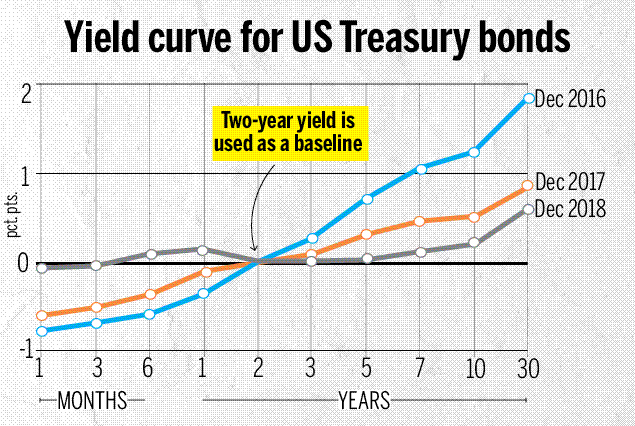
What is a Yield Curve?
The yield curve is a plot of the yields on all Treasury maturities (or debt sold by the federal government), ranging from 1-month bills to 30-year bonds. In normal circumstances, it has an arcing, upward slope because bond investors expect to be compensated more for taking on the added risk of owning bonds with longer maturities. When yields on the longer end of the curve are substantially higher than those on the shorter end of the curve, it is referred to as steep curve. So, a 30 year bond will deliver a much higher yield than a two-year note. When the gap, or “spread”, is less, it is referred to as a flat curve. In that situation, a 10-year note, for instance, may offer only a modestly higher yield than a 3-year note. It is a way to show the difference in the compensation investors are getting for choosing to buy shorter- versus longer- term debt. Most of the time, they demand more for investing their money for longer periods, due to greater uncertainty it brings. So, yield curves usually slope upward.
Importance of Yield Curve
The yield curve has the market’s sense of the economy, particularly about inflation. Investors who think inflation will increase typically demand higher yields to offset its effect. Because inflation usually comes from strong economic growth, a sharply upward-sloping yield curve generally means that investors have rosy expectations. An inverted yield curve, by contrast, has been a reliable indicator of impending economic slumps, like the one that started in 2007. In particular, the spread between three-month bills and 10-year Treasuries has inverted before each of the past seven U.S. recessions.
What are flat & inverted yield curve?
A yield curve goes flat when the premium, or difference, for longer-term bonds falls to zero — when, for example, the rate on 30-year bonds is no different than the rate on two-year notes. If the spread turns negative, the curve is considered “inverted.”
What is a Curve Inversion?
On rare occasions, some or all of the yield curve ceases to be upward sloping. This occurs when short- term investments in Treasury bonds pay more than long-term ones. While various economic or market commentators may focus on different parts of the yield curve, any inversion of the yield curve tells the same story: an expectation of weaker growth in the future.

Current Scenario
Since late 2018, markets have been concerned about the possibility of a global economic slowdown, in part due to the trade war between the U.S. and China. Those signs of weakness led the U.S. Federal Reserve first to pause the series of interest rate hikes it had been pursuing, and then to cut rates in July. At the same time, however, the Fed signaled that the cut wasn’t necessarily the start of a cycle of rate reductions. That statement kept yields on shorter-term debt anchored, while concern over the economy sent investors scrambling for the safety of long-dated Treasuries. That dropped U.S. 10-year yields below that of two-year Treasuries, while 30-year yields fell to a record low. In the U.K., 10-year yields dropped below that of two-year bonds. At the same time, Germany’s yield curve reached its flattest point since the financial crisis.
The gap between two- and 10-year yields dropped below zero on both sides of the Atlantic after a wave of soft economic data globally. Weaker-than-forecast Chinese retail sales and industrial output set the mood for the markets, with data later in the day showing Germany’s economy contracted, adding to the gloom.
The 2-year/10-year version of the yield curve has preceded each of the past seven recessions, including the most recent slowdown between 2007 and 2009. While there is no certainty how long the 2/10 curve will remain inverted, but it is almos upsetting the markets these days, and this inversion is pushing many to the brink of losing what was a deeply-rooted optimism for economic growth and equity prices.
An inverted yield curve, like most other indicators, is not perfect and doesn’t mean a recession is imminent. Some economist have argued that the aftermath of quantitative easing measures that saw global central banks snap up government bonds and drive down longer term yields may have robber inversions of their reliability as predictor. However, between that and the rising amount of negative- yielding debt in the world, strange things are happening with the bond market these days, and that’s what’s got investors on edge. For consumers, it’s reason for caution, but not panic.
To know more about this or any other financial matter, contact our financial advisor.
